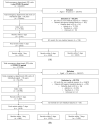A Comparison of Emergency Department Revisit Rates of Pediatric Patients between Pre-COVID-19 and COVID-19 Periods
- PMID: 35883987
- PMCID: PMC9322694
- DOI: 10.3390/children9071003
A Comparison of Emergency Department Revisit Rates of Pediatric Patients between Pre-COVID-19 and COVID-19 Periods
Abstract
Unscheduled revisits to emergency departments (EDs) are important because they indicate the quality of emergency care. However, the characteristics of pediatric patients visiting EDs changed during the coronavirus disease (COVID-19) pandemic, and these changes may have affected their revisit patterns. Therefore, we aimed to compare the ED revisit patterns of pediatric patients between the pre-COVID-19 and COVID-19 periods. This retrospective multicenter study included patients aged below 18 years who visited the ED in the pre-COVID-19 and COVID-19 periods. ED revisit rates were analyzed using five age groups and three visit-revisit intervals. In the pre-COVID-19 period, the revisit rates decreased with increasing age. In the COVID-19 period, the revisit rates were the lowest for the group aged 4-6 years, and the rates increased for those aged ≥7 years. In conclusion, there were changes in the patterns of revisit rates of pediatric patients according to age between the pre-COVID-19 and COVID-19 periods. Therefore, it is necessary to identify the reasons for revisits according to age and establish strategies to reduce the revisit rates of pediatric patients.
Keywords: COVID-19; pediatric patients; revisit to emergency department.
Conflict of interest statement
The authors declare no conflict of interest.
Figures
Similar articles
-
The impact of COVID-19 pandemic on revisits to emergency department.Australas Emerg Care. 2023 Sep;26(3):221-229. doi: 10.1016/j.auec.2023.01.002. Epub 2023 Jan 25. Australas Emerg Care. 2023. PMID: 36717326 Free PMC article.
-
Characteristics of an Unscheduled Emergency Department Revisit Within 72 hours of Discharge.Cureus. 2022 Apr 9;14(4):e23975. doi: 10.7759/cureus.23975. eCollection 2022 Apr. Cureus. 2022. PMID: 35541288 Free PMC article.
-
Comparing different patterns for managing febrile children in the ED between emergency and pediatric physicians: impact on patient outcome.Am J Emerg Med. 2007 Nov;25(9):1004-8. doi: 10.1016/j.ajem.2007.03.001. Am J Emerg Med. 2007. PMID: 18022493
-
Rates of 30-day revisit to the emergency department among older adults living with dementia: a systematic review and meta-analysis.CJEM. 2023 Nov;25(11):884-892. doi: 10.1007/s43678-023-00578-z. Epub 2023 Sep 2. CJEM. 2023. PMID: 37659987
-
[Unscheduled revisits in medical emergency units at the hospital: incidence and related factors].Med Clin (Barc). 1999 May 8;112(16):610-5. Med Clin (Barc). 1999. PMID: 10374176 Review. Spanish.
Cited by
-
Enhanced Diagnostic Precision in Revisited Emergency Patients via Point-of-Care Ultrasound: A Tool for Emergency Department Quality Management.J Multidiscip Healthc. 2025 Mar 18;18:1549-1556. doi: 10.2147/JMDH.S507075. eCollection 2025. J Multidiscip Healthc. 2025. PMID: 40125301 Free PMC article.
-
Early unplanned return visits to pediatric emergency departments in Israel during the SARS-CoV-2 pandemic.Am J Emerg Med. 2023 Jun;68:102-105. doi: 10.1016/j.ajem.2023.03.021. Epub 2023 Mar 17. Am J Emerg Med. 2023. PMID: 36963176 Free PMC article.
References
LinkOut - more resources
Full Text Sources




